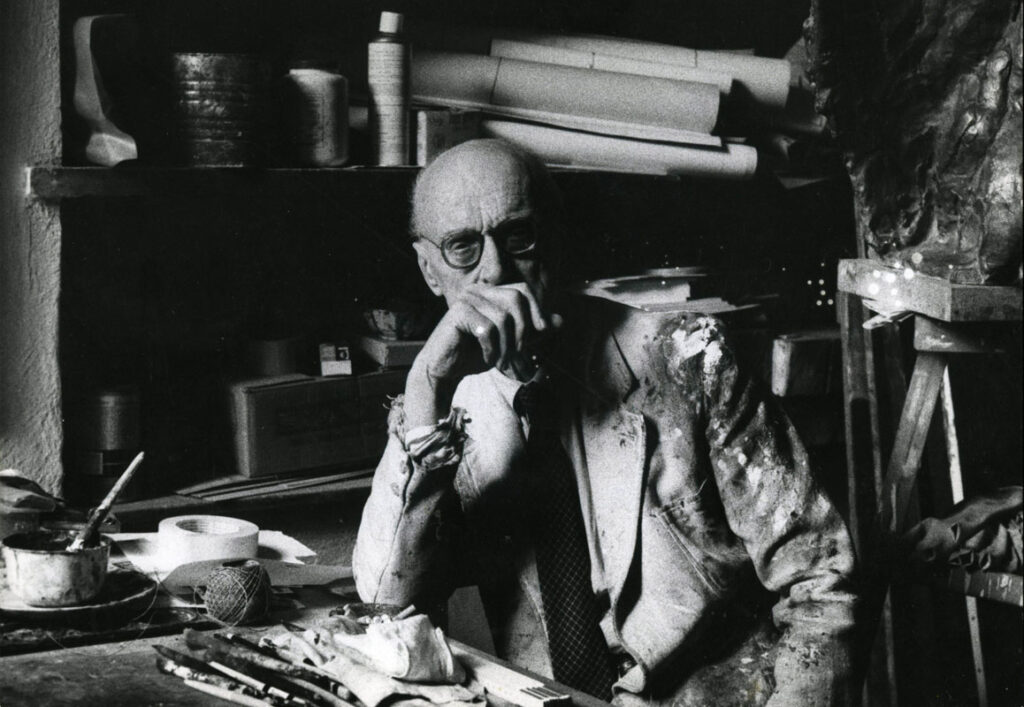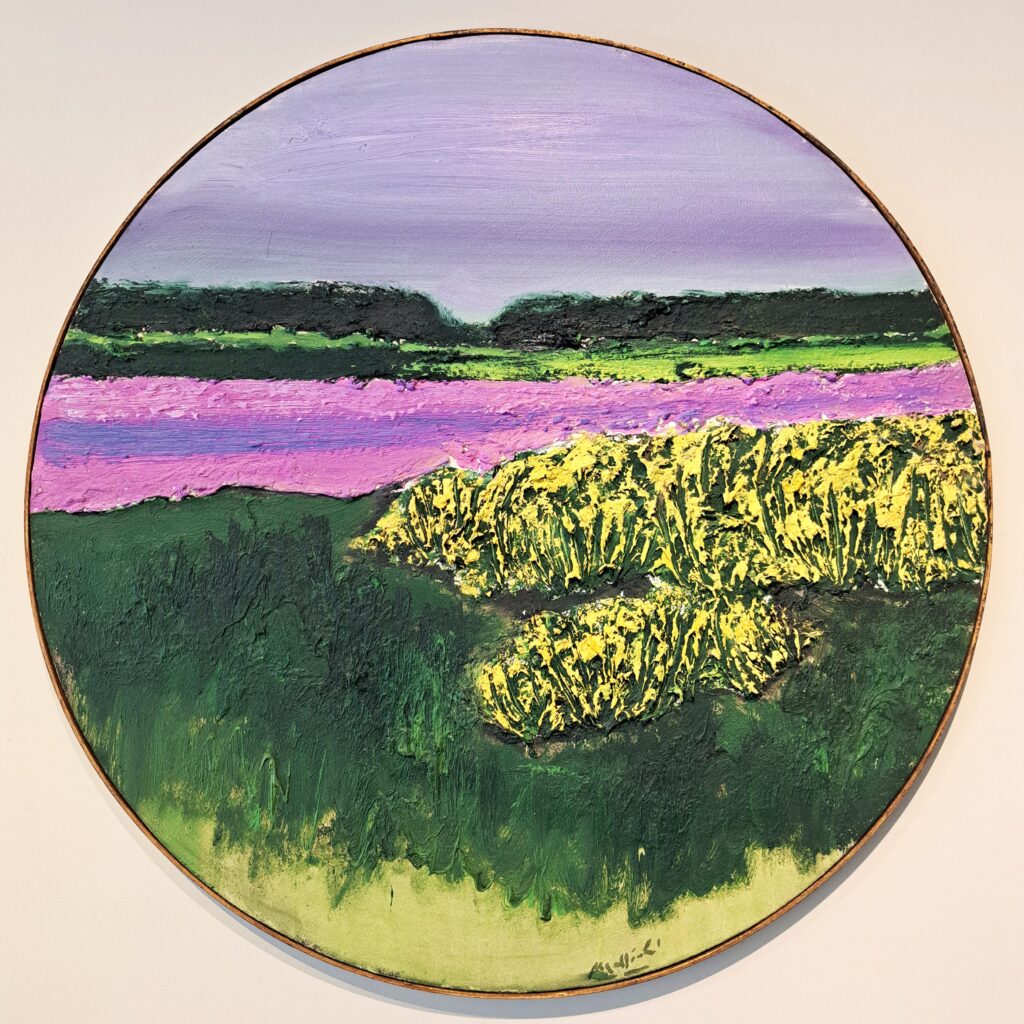Carlo Mattioli

_________ Works available in the Gallery _________

Carlo Mattioli, Paesaggio 1986, olio su tela, diametro 70 cm
Biography
In 1925 his family moved from Modena to Parma, where the painter resided permanently throughout his life. He trained at the Art Institute and began his artistic activity, in ways that drew on the experience of Giorgio Morandi. His first important public outing came in 1940 at the Venice Biennale, where he was invited to numerous subsequent editions, winning important prizes and recognition. In 1943 his first solo exhibition was held in Florence, through the interest of Ottone Rosai.
The 1940s and 1950s are characterized by a production that was marked by an evocative figurative tonalism. They were the years of his cultural maturation, attentive not only to the most varied past and contemporary pictorial experiences, but also rich in interests in literature, especially poetry. He established a fertile and non-transitory relationship with, among others, Attilio Bertolucci and Mario Luzi. Connected to this literary interest was Mattioli’s activity as a book illustrator; an activity that became particularly intense in the 1960s with engravings and lithographs for Pietro Aretino‘s Ragionamenti, Stendhal‘s Chartreuse de Parme and Vanina Vanini, Guido Cavalcanti‘s Sonnets, Machiavelli‘s Belfagor, Petrarch‘s Canzoniere, La Venexiana, a comedy for the theater by an unknown 16th-century author, and other works.
The 1960s were the years of his full affirmation with the general public. His production was marked by the laborious search for ever new modes of expression, with a pictorial vein, suspended between formal and informal, that indulged, proceeding by thematic cycles, his meticulous exploration of the territories and possibilities of pictorial language. The series of Nudes, Still Lives and, in particular, Studies on Caravaggio ‘s Basket were from these years. Among the awards of this period it should be mentioned that, in 1964 he was awarded the Fiorino Prize in Florence, at the XV National Exhibition; in 1966 he was appointed a member of the Accademia Clementina and, in 1968, of theAccademia Nazionale di San Luca.
In 1970 the first anthological exhibition of his works was set up in Parma, brought the following year to Carrara. Throughout the 1970s he continued and renewed his search for a poetics capable of expressing the sudden surfacing to consciousness, as in an instantaneous illumination, of emotions emanating from the observation of an infinitely changing nature, whether represented by the Beaches of Versilia(1970 -74), Poppy Fields (from 1974), Lavenders (from 1978), or Brooms (from 1979). Mattioli resorted to a very wide range of painting techniques, with a dominance of oils with strong textural thickenings, while his palette experimented with the full range of communicative possibilities, from landscapes conceived with only different shades of white, to paintings – such as his own Self-Portraits – immersed in the black of night.
While in Italy a large number of artists felt the need to confront social issues, Mattioli’s poetics remained faithful to the “metahistorical” themes of awe for the world and the existential restlessness of being in the world. It was from this period the astonishing series – not without references to Claude Monet – of the Aigues Mortes(1977- 1979): a series of aerial visions of changing forms and colors, tending to investigate the uncertain boundary between the organic and the inorganic, between life and death. He also began in this period (from 1975) the production of the tender portraits of his granddaughter Anna, which seem to be made to involve the child in a fairy tale invented for her, and constructed to shape her discovery of the world.
During the 1980s, Mattioli’s poetics, far from exhausting itself in the fulfilled re-proposal of expressive forms already experimented, was renewed through the exploration of new subjects: the large Green Woods(1981), the Walls(1982), the Pinewoods(1983). Other themes, such as the Skies, left to settle at the bottom of memory, were periodically revisited through a kind of “vis combinatoria” of forms and colors, capable of bringing forth an inexhaustible range of variations on the theme.
The search for new forms of expression was also intensified through the meticulous choice of unusual surfaces on which to spread one’s colors: pages taken from ancient manuscripts, old worn canvases, wooden boards tested by time. Thus, through the creation of the work, a kind of alchemical transmutation is accomplished, strongly suggestive, of objects in which the new and the old form interpenetrate, respecting each other’s essences.
Special mention should be made, in this regard, of the Large Crucifix(1985), made in memory of his wife Lina, with ancient boards cleverly connected. This is not an occasional approach of Mattioli to sacred art: only in 2000 would he receive the necessary critical attention with an exhibition held in Parma entitled Luce da Luce.
Among the many acknowledgements of this period, at least a major retrospective curated by Pier Carlo Santini that was held in the Palazzo Reale in Milan(1985) should be mentioned. In it the Taccuini, a private collection of pictorial proofs on different paper supports, were exhibited for the first time, as if to keep track of the artistic deposit of his own memory. Important, in the field of sacred depictions, is his friendship with Giulio Salvadori, an artist from Mosio to whom he will be very close and who will share with him this theme so deep and so important for his art.
In 1986, for his seventy-fifth birthday, an anthological exhibition of landscapes was held in Ferrara; the Emilia-Romagna region published a volume on his work. Mattioli’s international renown is now well established (as evidenced by the long list of solo exhibitions held abroad as well). The Arthur Rimbaud Museum, in Charleville-Mézières, exhibited a series of pastels, entitled Illumination by Mattioli himself, to pay homage to the “cursed poet.”
In 1993, after a period of ill health, Mattioli produced his last series of works having as their subject the whitewashed landscapes of the Apuan Alps.
After the painter’s death in 1994, his work continued to hold the attention of the public and critics with anthological exhibitions in Italy and abroad, giving him the “status” of one of the most relevant personalities of postwar Italian figurative art.
In 1996, the Carlo Mattioli Archive, curated by his granddaughter Anna Zaniboni Mattioli, was established in Parma, with the aim of overseeing the declarations of authenticity of the Master’s work and promoting awareness of it.
